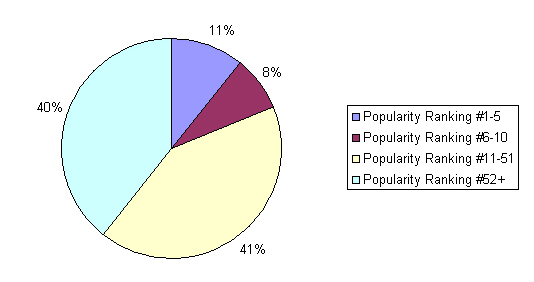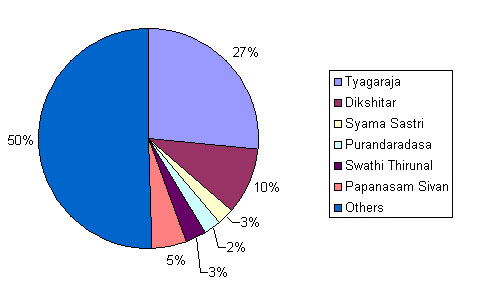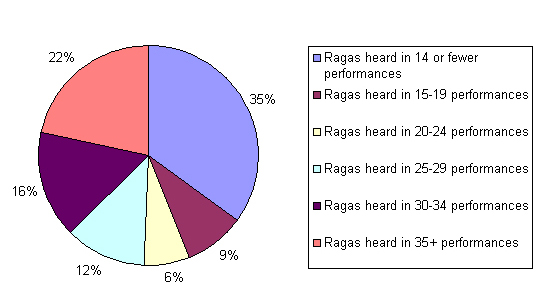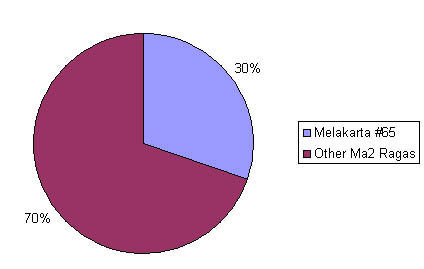This Database contains 2408 compositions heard in 286 different concerts. Although the database is available now for ongoing study, some initial observations can be summarized here.
Regarding ragas, 231 different ragas were were heard at least once in sample of attended concerts. This number must be understood, however, in the context of the over 2000 ragas described in Walter Kaufmann�s The Ragas of South India or the approximately 5000 ragas listed in Ragapravaham by M.N. Dhandapani and D. Pattammal.
Especially revealing is the dominance of the most common ragas. The five most popular ragas alone account for 11% of the total works performed, and the ten most popular ragas account for 19% of the total. The most popular fifth of the ragas heard (the top 51 ragas or 22% of the 231 different ragas heard) account for an astounding 60% of the total works performed!
Top 51 Ragas

Clearly, despite an almost infinite variety of possible raga choices, performers are choosing to work with a much smaller subset. Even more interesting is that our list of the top ragas includes only seven of the ragas included by Ravi Kiran, in his list of 25 popular ragas (Appreciating Carnatic Music, pp. 93-94). Future comparison with other such texts are necessary to determine if the perceptions of scholars and performers are substantiated or negated by this latest data.
Further information gathered from these concerts also reveals some interesting statistics. For example, in the area of tala (meter) the dominant tala (Adi) was used in 1462 performed works, 61% of the total. The top five talas are used in 89% of the works performed.
Top Five Talas

A similar dominance is found in the composers represented.
39% of performed works are compositions by the Carnatic �Trinity,� Tyagaraja,
Dikshitar, and Syama Sastri. Tyagaraja alone accounts for 27% of all performed
works, and the top five most popular composers account for an astounding
47% of performed works! These composers also account for 66% of the primary �centerpiece� compositions
in these concerts.
Top Six Composers

Despite the relative lack of variety in the above statistics, there is actually a very large number of different compositions which were performed in these concerts. The ten most popular works account for only 4% of the total performed works.
Most popular works:
Title/Composer/Raga/Number of Performances
"Chalamela Jese" (Rangaswamy Nattuvanar) Raga Natakurinji (12)
"Deva Deva" (Swathi Thirunal) Raga Maya Malava Gowla (11)
"Era Napai" (Patnam Subramania Iyer) Raga Thodi (12)
"Ewari Bodhana" (Patnam Subramania Iyer) Raga Abhogi (10)
"Karunimpa" (Thiruvottriyur Thyagayyar) Raga Sahana (10)
"Kurai Ondrum Illai" (Rajaji) Ragamalika (12)
"Manadirkugandadhu" (Thanjavur Sankara Iyer) Raga Sindhu Bhairavi (10)
"Srinivasa Thiruvengada" (Papanasam Sivan) Raga Hamsanandhi (11)
"Swaminatha Paripalayasumaam" (Dikshitar) Raga Nattai (11)
"Valachi" (Patnam Subramania Iyer) Ragamalika (13)
"Viriboni" (Pachimirium Adiyappayya) Raga Bhairavi (10)
Compositions Using Popular Ragas

There is a clear preference by performers (in deference
to their audiences, perhaps?) for ragas using the pitch Ma1 (as opposed to
Ma2).
Ragas Using Ma1 and Ma2

Asingle melakarta raga
("Kalyani" — #65) is the source
for 30% of all items using Ma2.
Melakarta #65 versus other Ma2 Ragas

In the larger selection of Ma1 ragas, there are also clear
favorites: the five most popular melakarta ragas (#15, 20,
22, 28, 29) account
for 78%
of all Ma1 items.
Dominant Ma1 Melakarta Ragas


